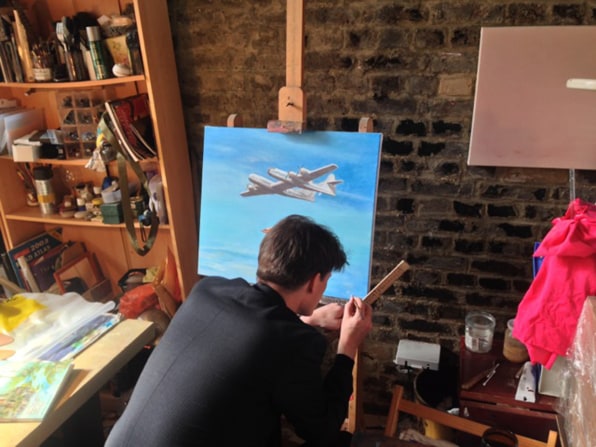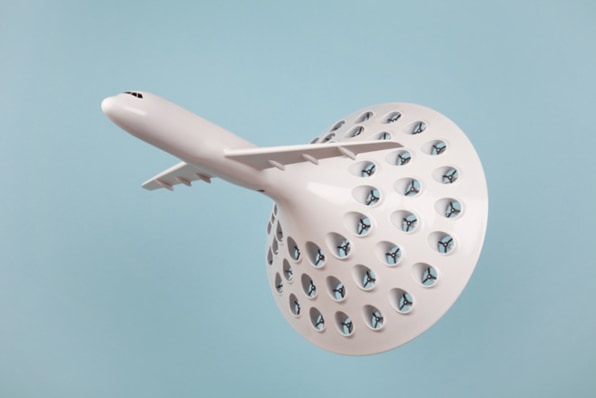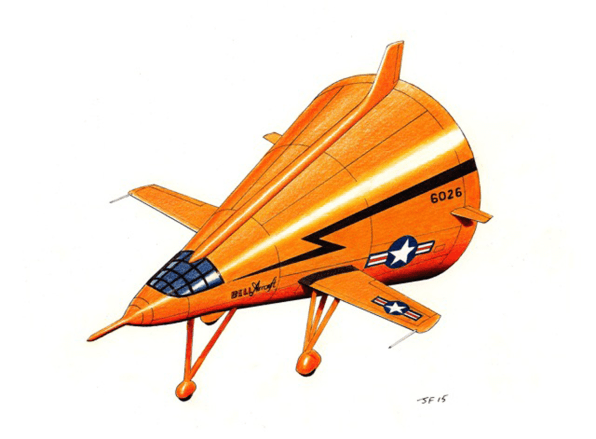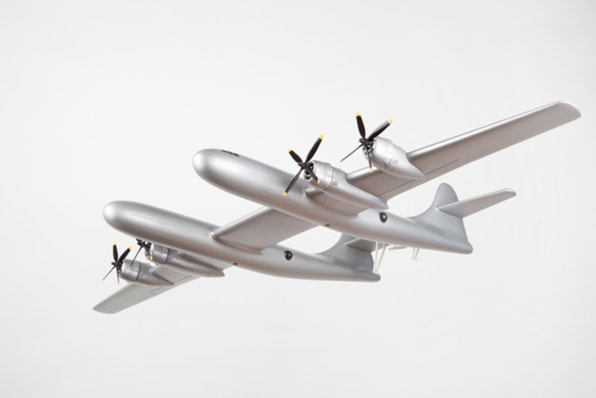
For all their convenience, airplanes are one of the dirtiest modes of transportation out there. A fully loaded A380’s CO2 output is equivalent to each passenger driving six cars an equivalent distance. But what if airplane designers in the 1940s and 1950s had worked to embrace energy sources besides petroleum? How might the history of aviation have played out?
That’s the question posed by Royal College of Art graduate Tim Clark, who imagines an alt-history of aviation in which planes were designed to be powered by sonic booms and nuclear engines. Clark’s project, High-Speed Horizons, hopes to jumpstart what he considers “stagnated” Earth-based aerospace innovation by proposing four Golden Age plane designs that could have been:

The Boomjet “SBT” — The Boomjet is probably Clark’s most arresting design: an aircraft with the body of a Boeing 767 and a billowing skirt of a tail that contains 47 separate propellers. Inspired by the shape of a sonic boom, the Boomjet’s propellers allow the Boomjet to take off vertically like a helicopter from a launchpad-like structure. And thanks to the Boomjet’s shape and propellor, the power of its sonic boom can actually propel it forward. Unless there’s a body of water nearby, though, emergency landings are going to be a rocky affair. In the same way that SST was the preferred aviation acronym for talking about supersonic transport planes such as the Concorde, SBT stands for “sonic boom transport.”

The X-1SB — Designed in 1947, the Bell X-1 was the first plane to break the sound barrier. An insanely simple design, the X-1 was designed after the specs of a .50 caliber bullet, essentially because the engineers knew that a bullet was stable above Mach 1. In Clark’s alternate history of Cold War aviation, the X-1 was followed by a sister plane, the X1-SB, which combines a .50 caliber bullet with the shock wave that results from breaking the sound barrier. The “humorously tiny wheels,” Clark says, were inspired by a real-life plane: the V-173 Flying Pancake (not to be confused with the Navy’s X-150 Submersible Waffle).

The B-29 Duo “Double Mama” — The original Bell X-1 couldn’t take off by itself: it was designed to go really fast once airborne, but to actually get in the sky, it had to be airdropped by a Boeing B-29 Superfortress. With its even more unwieldy shape, Clark figures the X1-SB will have a similar problem, so he designed a dual-fuselage B-29, the “Double Mama,” to haul it up into the stratosphere. And while a double-bodied plane might look weird, it’s actually not that unconventional. This is the same family of aircraft that tows Virgin Galactic’s SpaceShip Two to release altitude

The Air Laissez-Faire — In the wake of disasters like Chernobyl and Fukushima, it seems pretty obvious why we don’t put nuclear reactors inside machines that semi-regularly come crashing out of the sky. During the Cold War, though, both the United States and Soviet Union extensively researched nuclear-powered aircraft. Air Laissez-Faire imagines what would have happened if this technology had hit the open market. Powered by a nuclear reactor, Air Laissez-Faire is a 518-foot plane that always stays airborne, mashing up design elements from the Rockwell B-1 Lancer and the Concorde. Clark imagines it as a potential meeting place for globe-trotting businessmen: instead of flying all the way to Tokyo to meet your Japanese business partners, why not meet on Air Laissez-Faire, hopping aboard as it passes by?
Although his alt-history airplane designs look weird and whimsical, Clark insists that all of them would fly, save the Boomjet. “The drag caused by the back of the Boomjet makes it hard to believe it would work,” Clark says. Even so, he argues, implausible designs are all part of the history of aviation. “Every airplane design, aerodynamic or not, is an attempt to solve a problem and spark innovation,” Clark says. And in a warming world, what better problem could be worth solving than the aerospace industry’s addiction to fossil fuels?
—
Seeking to build and grow your brand using the force of consumer insight, strategic foresight, creative disruption and technology prowess? Talk to us at +971 50 6254340 or engage@groupisd.com or visit www.groupisd.com/story
